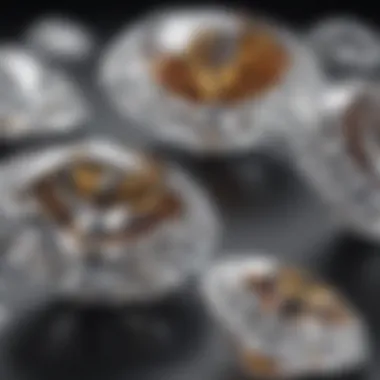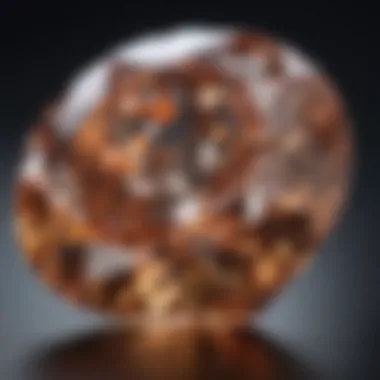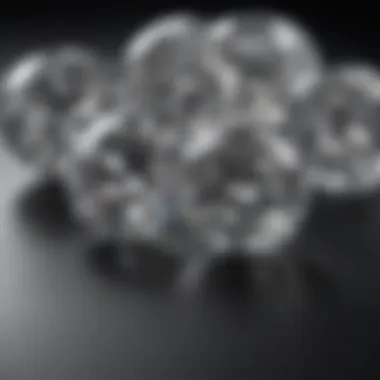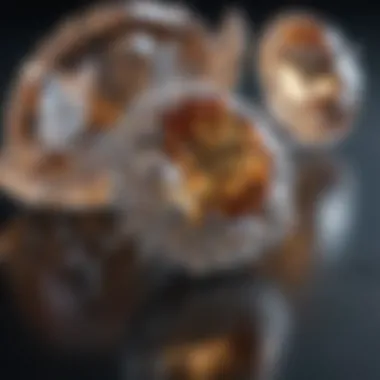Converting 3 Carat Diamonds to Millimeters Explained


Intro
The world of gemstones is rich and intricate, drawing the interest of many, including gem enthusiasts and collectors. Diamonds particularly capture attention, and understanding their measurement can enhance the buying experience. The conversion of carat weight into millimeter dimensions is a crucial aspect that affects how diamonds are viewed and valued. This piece aims to enable readers to not only comprehend the significance of a three-carat diamond but also to lay the groundwork for discerning quality when purchasing these exquisite gems.
Gemstone Overview
Definition of Gemstones
Gemstones are precious or semi-precious minerals that have been cut, polished, and used for adornment or other decorative purposes. They are valued for their beauty, rarity, and durability. Diamonds, as a specific type of gemstone, hold unique traits that make them particularly pursued in the jewelry market. Their hardness and brilliance, combined with the mystique surrounding them, create a strong allure.
Classification of Gemstones
Gemstones can be classified into several categories based on various criteria. The most common classifications include:
- Precious Gems: These typically include diamonds, rubies, sapphires, and emeralds. Their value is often dictated by both rarity and perceived beauty.
- Semi-Precious Gems: This category includes gemstones that are more common, like amethyst, aquamarine, and garnet. They still carry significant beauty but are generally more accessible in the market.
Colloquially, the term 'gemstone' is often interchangeable with 'precious stone.' However, the distinction is meaningful in understanding market value and buyer expectations.
Historical Significance
Origins of Gemstone Use
Historians trace the use of gemstones back thousands of years. Ancient civilizations mined them for various purposes, including jewelry, trade, and even spiritual beliefs. For example, the ancient Egyptians valued gemstones like lapis lazuli, using them in talismans and burial artifacts. Diamonds, on the other hand, were first recognized for their strength and brilliance in ancient India, where they were associated with divine qualities.
Cultural Insights: Gemstones in Ancient Civilizations
Different cultures assigned unique meanings and values to gemstones. In Roman society, for instance, gemstones were believed to confer protection and healing properties. Similarly, in Eastern cultures, specific stones were used to mark significant life events, signifying status or spiritual connection. This historical context enriches the understanding of gemstones today.
"The value and allure of gemstones persist through history, as they encapsulate beauty, culture, and human emotion."
In summary, the journey of diamonds from their geological formation to their role in jewelry reflects a significant cultural narrative. For the discerning buyer, knowing this context could influence stone selection and appreciation.
Through this exploration, the subsequent sections will dissect the conversion of carat weight to millimeters, providing a foundation for better understanding and evaluating three-carat diamonds in particular.
Preamble to Carat and Millimeter Measurements
Understanding the relationship between carats and millimeters is essential in the gemstone market. This knowledge aids in making informed decisions when purchasing diamonds or any gemstones. The carat weight is a standard measure of gem weight, while millimeters provide insights into the actual dimensions. An accurate grasp of these measurements is not only relevant for buyers but also for collectors, jewelry designers, and even geology enthusiasts. It broadens the comprehension of what constitutes quality and value in gemstones.
Each unit, carat and millimeter, serves a distinct purpose. Carats denote how much a diamond weighs, directly impacting its value and desirability. Millimeters, on the other hand, indicate size and help visualize how the diamond will look in jewelry. Thus, merging these metrics plays a significant role in gemstone appreciation.
Buyers should recognize that a given carat weight does not provide a complete picture of a diamond's overall size, as it can vary depending on its shape and cut. This is especially true when considering the aesthetic aspects of a diamond. Knowing how to convert carat weight into millimeters enhances decision-making abilities, ensuring buyers select pieces that not only appeal to their taste but also meet their expectations for size and appearance.
Important Insight: Carat weight might suggest a diamond's value, but the size perception is shaped by millimeter measurements.
In this article, we will delve deeper into the definitions of carat and millimeter, their unique roles in gemstone valuation, and the nuances of their conversions. By the end of our exploration, both novice and experienced gem enthusiasts will be equipped with the knowledge needed to navigate the complex world of diamonds and gemstones.
The Carat as a Weight Measurement
Carat weight is one of the most fundamental aspects of diamond assessment. It serves not only as a measure of weight but as an indicator of value and size in the gemstone market. Understanding carat weight is crucial for consumers, collectors, and jewelry designers alike. When evaluating a diamond's price, the carat weight can significantly influence what is paid. A higher carat weight often leads to a higher price, so grasping this measurement helps inform smarter purchasing decisions.


Understanding Carat Weight
A carat is a unit of weight equal to 200 milligrams. The word itself originates from the carob seeds that were once used as a standard for weight in trade. The weight of a diamond does influence its perceived value; however, it is not the sole factor. While carat weight gives an objective metric, it does not fully encapsulate the beauty and appearance of the diamond.
Evaluating diamonds solely by carat weight can lead to missed opportunities in quality. For example, two diamonds may weigh the same in carats but appear different in size due to their cut or shape. Moreover, maintaining a balance between carat weight and other characteristics like clarity and color is vital.
The Relationship Between Carat and Size
The relationship between carat weight and actual size is not linear. Indeed, a substantial increase in carat weight does not always correspond to a proportionate increase in size. This phenomenon can be attributed to the shape and cut of the diamond.
For instance, a well-cut round diamond can appear larger than a poorly cut diamond of the same weight. In general, the formula for estimating millimeter size from carat weight varies depending on the diamond shape. Here are approximate sizes for common shapes:
- Round: 3 carat diamond is typically about 9.4 mm in diameter.
- Princess: 3 carat diamond is usually approximately 8.7 mm.
- Emerald: 3 carat diamond can measure around 10 x 7 mm.
"Understanding how carat weight translates to size can prevent buyers from overpaying or choosing a diamond that does not meet their expectations."
Carat weight alone can sometimes mislead buyers regarding the overall appearance. Factors such as cut quality can enhance the visual size of a diamond, affecting how light interacts with its facets, giving it a more pronounced appearance without needing increased carat weight. It is essential to consider both carat weight and the cut quality for a balanced assessment of the diamond.
Millimeter as a Size Measurement
The measurement of gemstones, particularly diamonds, in millimeters is crucial for various reasons. Unlike carats, which denote weight, millimeter measurements provide a tangible representation of the physical size of the diamond. This is important not just for aesthetic considerations but also for practical implications when assessing the suitability of the diamond for different settings or for matching with other stones.
Understanding the importance of millimeter measurements enhances the buyer's perspective significantly. For jewelry designers, precise dimensions allow for thoughtful design that optimally showcases each stone's unique facets and brilliance.
Overall, millimeter specifications offer a different lens through which to evaluate gemstones, crucial for ensuring satisfaction in both purchase and design.
Interpreting Millimeters in Gemstone Dimensions
Interpreting millimeter dimensions revolves around recognizing how they relate to a diamond's physical characteristics. For diamonds, this is usually represented using a few key measurements: diameter for round brilliant cuts and length, width, and depth for fancy shapes.
- For round diamonds, 3 carats typically convert to a diameter of approximately 9.4 millimeters. This size can greatly affect the appearance of the diamond when set in jewelry.
- In fancy shapes, like oval or pear cut, the millimeter sizes will differ from round shapes, usually requiring calculations based on both length and width.
Accurate interpretation of these millimeter dimensions ensures buyers understand the actual size of the diamond they are acquiring, thus empowering informed choices in their purchases.
How Millimeter Measurements Vary Among Gem Types
Millimeter measurements vary significantly among different types of gemstones. Each gemstone type has unique characteristics that influence how size is perceived. For instance, a 3-carat diamond might appear different in size compared to a 3-carat sapphire due to variations in density and refractive indices.
- Diamonds: High luster and brilliance can make them look larger.
- Sapphires: Often denser, they may appear smaller than their diamond counterparts.
- Emeralds: The cut and clarity often affect their perceived size as well, with inclusions potentially making them look smaller.
Ultimately, understanding these variations helps buyers calibrate their expectations when comparing different gemstones, making it essential knowledge for any gemstone enthusiast.
Converting Carats to Millimeters
The conversion of carats to millimeters is a fundamental concept in the gemstone market, especially for diamonds. Knowing how to accurately translate carat weight into size can significantly influence purchasing decisions. Many buyers equate carat weight with size, but this is not always a direct correlation. This section aims to clarify the importance of understanding these conversions, as well as provide practical information that can enhance the knowledge of gemstone enthusiasts and collectors.
Understanding how carat weight relates to a diamond's physical dimensions allows buyers to make informed choices about their purchases. It also helps in comparing different gemstones. For example, two diamonds may have the same carat weight, but their sizes may differ due to factors like cut quality, clarity, and overall shape. Buyers should be prepared to evaluate these aspects before making a commitment.
In summary, the conversion from carats to millimeters is an essential skill for anyone involved in gemstone selection or appraisal. This understanding can search further into the intricacies of diamond valuation.
Standard Carat to Millimeter Conversion Guide


When converting carats to millimeters, it helps to rely on established conversion standards. Typically, a one-carat diamond measures approximately 6.5 mm in diameter when optimally cut. However, this can vary based on its cut shape. Below are some common conversions for various shapes of diamonds:
- Round: A one-carat round diamond is usually around 6.5 mm.
- Princess: For a princess cut, a one-carat can be about 5.5 mm.
- Emerald: This cut tends to be longer and can be about 7.0 mm.
- Oval: An oval cut diamond may measure around 7.0 mm by 5.0 mm for one carat.
It is important when comparing, to take into account that each shape has specific dimensions. A round diamond will appear different from a cushion-cut diamond, even if they have the same carat weight. The varying cut styles greatly influence how a diamond's size is perceived.
"Accurate conversions enrich the understanding of both buyers and jewelers alike, ensuring that size expectations align with reality."
Example Calculation: Converting Carats
To convert 3 carats into millimeters, one needs to apply the established conversion of carats to diameter. For a round diamond, using the standard, a 3-carat diamond typically measures around 9.3 mm in diameter. The formula in this case is:
- Diameter (mm) = Carat weight × Constant
The constant here, based on the approximate diameter for one carat (6.5 mm), would be:
Keep in mind that this calculation specifically addresses round diamonds, and other shapes will have different sizes. Therefore, when evaluating a diamond or considering a purchase, checking the exact proportions will be crucial for precise understanding.
Factors Influencing Size Appearance
The perceived size of a diamond is not solely determined by its carat weight. Instead, several factors influence how the size is perceived by the eye. Understanding these factors can greatly enhance your appreciation of gemstones and help inform purchase decisions. When considering a 3 carat diamond, buyers should pay attention to the nuances of these aspects for the best value and appearance.
Cut Quality and Its Impact on Size Perception
The cut of a diamond refers to how well it has been shaped and polished. It significantly affects both brilliance and overall appearance. A well-cut diamond will reflect light in a manner that can make it seem larger than its actual size. In contrast, a poorly cut diamond may appear smaller and less attractive, even if it weighs the same as a better-cut stone.
Consider these factors regarding cut quality:
- Symmetry: Well-symmetrical diamonds tend to reflect light evenly, enhancing their appearance.
- Proportions: The depth and table size can influence how light enters and exits the diamond. A shallow cut might cause light to leak out, while a deep cut can inhibit light reflection.
- Faceting: The number and arrangement of facets on the diamond's surface can also change how it looks. More intricate faceting can lead to greater perception of size.
Investing in a diamond with high cut quality ensures that the stone’s brilliance is maximized, giving the illusion of a larger size without the need for a higher carat weight.
Color and Clarity Considerations
Color and clarity are vital aspects that contribute to a diamond's visual impact. When evaluating a 3 carat diamond, the balance between these traits may affect not just aesthetics but also perceived size.
- Color: The hue of a diamond can influence how its size is perceived. Colorless diamonds allow more light to pass through, enhancing sparkle and making the stone appear larger. On the other hand, diamonds with visible color may absorb some light, thus influencing the perception of size.
- Clarity: Clarity grades indicate the presence of inclusions or blemishes. A diamond that is eye-clean (free of blemishes visible to the naked eye) will radiate light more effectively. Inclusions may disrupt light paths, making the diamond seem smaller and less brilliant.
To summarize, selecting a diamond requires consideration of cut, color, and clarity—each plays a role in how the size is perceived. Buyers should recognize that these elements can easily overshadow mere carat weight when evaluating the overall appearance of a diamond. The value of investing in a diamond lies not only in its numerical specifications but also in how it resonates with personal preferences and the attention it commands.
Practical Implications for Buyers
Understanding how carat weight translates into millimeter dimensions is vital for anyone looking to invest in diamonds. Buyers often seek to gauge both the aesthetic appeal and value of a gemstone based on size and weight. Carats represent the weight, while millimeters give dimensions, which reflect how a diamond will appear when set in jewelry. Recognizing this relationship can significantly influence a buyer's choice, helping them avoid pitfalls when selecting a diamond.
One critical benefit of understanding these measurements is that they can guide you in comparing diamonds accurately, enabling an informed purchasing decision. Carats alone can be misleading. For example, two diamonds of the same carat weight may look different in size due to variations in cut quality. Therefore, awareness of how these two metrics relate is essential for a satisfactory purchase experience.
Buyers should also consider how their choices affect the emotional and visual qualities of the gemstone. Each diamond's cut, color, and clarity can combine with size to create an impression that resonates personally with the buyer. Thus, grasping how to interpret size effectively can lead to more rewarding acquisitions and a deeper appreciation of the gemstone's beauty.
> Understanding both carats and millimeters enhances a buyer's confidence in making substantial purchasing decisions.


How to Choose Based on Size and Weight
Choosing a diamond requires careful consideration of both size and weight. When comparing diamonds, identifying how a specific carat weight translates into visual size is essential. Diamonds can have the same carat weight but differ greatly in diameter and appearance due to their cut quality. For instance, a well-cut diamond can appear larger than a poorly cut one of the same carat weight.
Focus on the millimeter measurements of the diamond. Typically, a three-carat round brilliant diamond may approximate 9.4 millimeters in diameter, depending on the cut and proportionality. This size is often seen as a significant statement piece in the jewelry market. Buyers should look for varying shapes as well, as the impact on apparent size can differ. For example, a princess-cut diamond of three carats can appear smaller than a round cut due to its faceting and silhouette.
When choosing based on size and weight, it may be helpful to consult with a jeweler. They can provide insights and show examples to clarify any uncertainties about size perception. Furthermore, it’s wiser to prioritize quality over quantity, ensuring that the chosen diamond reflects both beauty and value.
Gemstone Settings and Their Size Considerations
The choice of gemstone settings can greatly influence how a diamond's size is perceived. Settings play a critical role in framing the diamond, effectively altering its overall appearance. A well-chosen setting can enhance a diamond’s size and brilliance.
Common types of settings include:
- Solitaire: This classic design puts a single diamond at the forefront, making it appear larger by reducing visual clutter.
- Halo: Surrounding the center diamond with smaller stones makes it appear significantly larger and adds brilliance.
- Three-stone: Allows for a broader presentation while emphasizing the central diamond’s size.
Each setting interacts differently with the diamond’s size and weight. For example, a halo setting could make a smaller diamond look larger, while an overly intricate setting can distract from the diamond itself. Buyers should ensure that the setting complements the diamond’s size and enhances its visual appeal.
Ultimately, understanding both the implications of carat weight and the factors affecting size perception can lead to more satisfying and intelligent purchases in the gemstone market.
Investing in Diamonds: What to Know
Investing in diamonds is a complex undertaking that requires a clear understanding of various factors, including carat weight, quality, and market dynamics. Diamonds have long been seen as a store of value, but navigating this space demands knowledge that goes beyond the surface. Understanding the nuances of carat-for-millimeter conversions is essential for assessing the true worth and appearance of a diamond. This knowledge not only helps in making informed purchase decisions but also allows investors to comprehend the long-term value implications associated with each stone.
Understanding Value Beyond Size
When investors think about diamonds, the carat size often comes to mind first. However, the value of a diamond extends well beyond its weight. Quality factors such as cut, color, and clarity significantly influence a diamond's market price. A smaller diamond with superior cut and clarity may hold more value than a larger stone that lacks these qualities. In addition to the basic metrics of size and weight, several aspects contribute to value:
- Cut Quality: This term refers to how well the diamond has been shaped and faceted. A well-cut diamond can appear larger and more brilliant.
- Color Grade: Diamonds are graded on a scale from D (colorless) to Z (light yellow or brown). The minimal presence of color often increases the stone’s value.
- Clarity: Clarity addresses the presence of internal or external flaws. Fewer imperfections lead to a higher value.
If you're considering a three-carat diamond, take the time to evaluate these factors alongside the weight measurement. An investment in diamonds should be seen as a package of quality attributes, not merely a number on the scale.
Market Trends Related to Carat Weight
The diamond market is subject to fluctuations and trends that can affect pricing and demand. Carat weight often influences perceived value, creating specific market behaviors. Understanding these market dynamics can assist savvy investors in making strategic purchases. Notable trends include:
- Consumer Preferences: Current trends show a shift towards unique, lower-carat stones that emphasize craftsmanship and style rather than sheer size.
- Resale Value: Larger diamonds, especially over three carats, might carry a higher resale appeal, but they can also attract a premium that does not necessarily equal investment return.
- Economic Indicators: Market conditions, such as consumer spending and luxury goods demand, can impact diamond pricing. Tracking these indicators can provide insights into timing your investments.
"In diamonds, as in any investment, understanding market trends is key to making wise choices."
Ending: Beyond Numbers
The conversion of carats to millimeters provides essential insight into the physical aspects of diamonds. However, understanding this conversion allows one to appreciate the gemstone beyond mere numbers. The emphasis here is on recognizing that each diamond carries not only its metrics but also an aesthetic and emotional resonance that influences buyer decisions.
The Aesthetic and Emotional Value of Gemstones
When considering diamonds, it is impossible to overlook their undeniable beauty. The aesthetic appeal of a diamond is closely linked to its cut, clarity, color, and carat weight. While millimeter size can indicate a diamond's physical presence, the emotional value often outweighs this. Many individuals associate diamonds with significant life events, such as engagements and anniversaries, creating a profound emotional attachment. This emotional aspect varies noticeably between individuals. Each diamond potentially tells a unique story, making its holding a personal experience.
It's important to note that the aesthetics are not merely based on measurements. The settings, styles, and personal preferences also play a vital role. Custom settings can enhance the appearance of a diamond, making it appear larger or more impressive than its actual dimensions. Thus, while measurements hold their importance, the emotional context remains paramount in determining the true value of a diamond.
Final Thoughts on Carats and Millimeters in the Gemstone Market
The dialogue surrounding carat weight and millimeter size is complex. Gemstone enthusiasts, collectors, and jewelry designers must go beyond the numbers for informed decisions. Understanding the conversion between these measurements aids in assessing potential purchases, but also informs discussions about value and desirability. Market trends showcase how buyers increasingly consider quality over sheer size.
This trend is essential in today's marketplace, where unique and high-quality gems can provide better returns than larger, less visually appealing stones. Thus, it is critical for buyers to focus not solely on the carat or millimeter dimensions but also on the holistic qualities that bring true value to a gemstone.
Through this understanding, buyers can approach their selections thoughtfully, ensuring they appreciate each diamond for its full spectrum of value.



